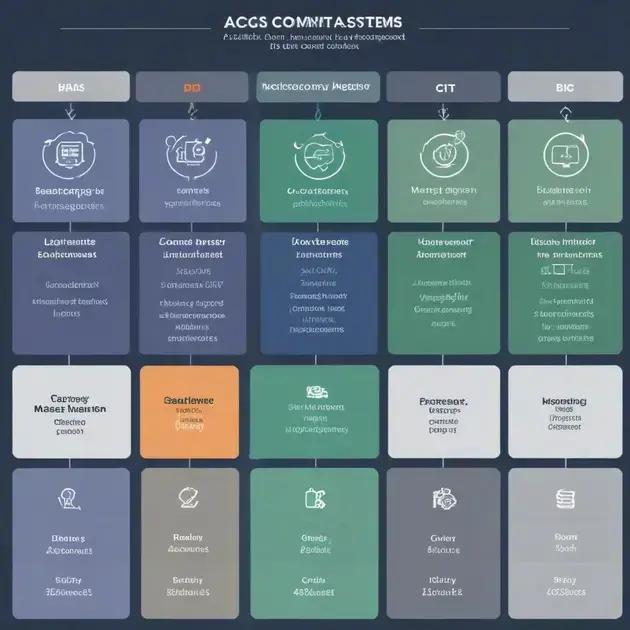An account management system is a vital tool that streamlines customer interactions, enhances relationships, and improves operational efficiency. By automating tasks and providing valuable insights, it empowers businesses to manage client accounts effectively, leading to increased satisfaction and revenue.
An account management system is crucial for organizations looking to streamline their operations and enhance customer relationships. By adopting the right solutions, businesses can manage client interactions more effectively, track user data, and ensure all accounts are handled with precision. This article delves into what an account management system does, its vital features, and the benefits it brings to your business.
What is an Account Management System?
An account management system is a digital tool designed to help businesses manage customer accounts efficiently. It integrates various functions such as tracking accounts, managing client relationships, and automating communication processes.
Understanding the Components
Key components of an account management system include customer databases, reporting features, and communication tools. These components allow businesses to keep detailed records of customer interactions and preferences, providing a holistic view of client engagement.
By utilizing such systems, businesses can streamline account-related processes, ensuring that no details slip through the cracks. Furthermore, these tools often enable businesses to categorize accounts based on various criteria, enhancing targeting and service delivery.
Importance for Businesses
Having an efficient account management system in place is crucial for maintaining customer satisfaction. By providing timely updates and personalized communications, businesses can foster stronger relationships with their clients. The system also helps in identifying opportunities for upselling and cross-selling services.
Common Features
Most account management systems offer tools such as task management, client segmentation, and performance tracking. These features are essential in providing insights about account statuses and making data-driven decisions to improve service offerings.
Overall, an account management system serves as the backbone for managing client relationships, ensuring that all interactions are tracked and managed effectively.
Key Features of Account Management Systems

Account management systems come with a variety of key features that streamline processes and enhance client interactions. Understanding these features is essential for businesses looking to improve efficiency and customer satisfaction.
1. Customer Database
A comprehensive customer database allows businesses to store information about their clients in one place. This includes contact details, account histories, and preferences, making it easy to access important information quickly.
2. Communication Tools
Integrated communication tools help foster communication between businesses and clients. These tools can include email platforms, messaging systems, and even chat functionalities. By keeping communication streamlined, businesses can respond to clients faster.
3. Task Management
Effective task management features help teams track tasks associated with each client account. This ensures that no responsibilities are overlooked and that follow-ups are timely, which enhances service delivery.
4. Reporting and Analytics
Reporting and analytics capabilities allow businesses to assess account performance. Through dashboards and reports, companies can gauge client engagement, sales trends, and areas needing improvement, informing strategic decisions.
5. Customization Options
Customization features enable businesses to tailor the management system to their specific needs. This includes setting up unique workflows, branding, and personalized client interactions, which can boost the overall client experience.
Benefits of Using an Account Management System
Using an account management system provides several critical benefits that can enhance a business’s ability to manage client relationships and streamline operations.
1. Improved Efficiency
One of the primary benefits is increased efficiency. By automating routine tasks such as data entry and communication tracking, businesses can save time and allocate resources to more strategic activities.
2. Enhanced Customer Relationships
Account management systems offer tools to personalize customer interactions. By having access to detailed customer histories and preferences, businesses can provide tailored services that improve customer satisfaction and loyalty.
3. Better Data Management
These systems centralize customer data, making it easier to manage and analyze. With a single source of truth, businesses can avoid errors that arise from using multiple data sources and ensure that they make informed decisions.
4. Increased Revenue Opportunities
Effective account management can lead to increased upselling and cross-selling opportunities. By understanding customer needs and trends, businesses can offer relevant products or services that enhance revenue streams.
5. Enhanced Reporting and Analytics
Account management systems come equipped with reporting and analytics features that help businesses track performance and client engagement over time. This data is essential for assessing the effectiveness of strategies and making necessary adjustments.
Choosing the Right Account Management System

Choosing the right account management system is a crucial decision for any business. With various options available, it’s important to evaluate the best fit for your specific needs and circumstances.
1. Identify Your Needs
Start by assessing your business requirements. Consider the size of your client base, the complexity of your services, and how you interact with clients. Knowing what you need helps narrow down choices and ensures that the system you select meets your operational demands.
2. Evaluate Features
Different account management systems come with unique features. Look for essential functionalities like customer database management, communication tools, and reporting capabilities. Ensure the system you choose aligns with the needs identified earlier.
3. User-Friendliness
A good account management system should be easy for your team to use. A user-friendly interface can reduce the learning curve and increase adoption rates. Request demos to see how intuitive a platform is before making a decision.
4. Scalability
As your business grows, your account management system should be able to grow with it. Choose a system that offers scalability options, allowing you to add features or users as needed without significant disruptions.
5. Cost Considerations
Finally, consider the total cost of ownership. Beyond the initial purchase price, account for ongoing maintenance, updates, and potential training costs. Balance these expenses against the benefits the system will bring to ensure you’re making a sound investment.
Tips for Implementing an Effective Account Management System
Implementing an effective account management system can significantly improve how a business manages client relationships. Here are some tips to ensure a successful implementation.
1. Involve Your Team
Get your team involved in the implementation process. Gather feedback from staff who will use the system daily. Their insights can help tailor the system to meet practical needs and ensure better adoption among users.
2. Provide Comprehensive Training
Training is crucial for a successful rollout. Offer training sessions that cover all aspects of the system. This ensures that all team members, regardless of their tech-savviness, feel comfortable using the new tools.
3. Start with a Pilot Program
Consider running a pilot program before fully implementing the new system. This allows you to test the software in a controlled environment, troubleshoot potential issues, and gather user feedback before a complete launch.
4. Set Clear Goals
Establish clear objectives for what you want to achieve with the account management system. Whether it’s improving response times or increasing customer satisfaction, having specific goals helps measure success post-implementation.
5. Regularly Review and Update
After implementation, regularly review the system’s performance. Gather feedback from users and look for areas of improvement. Technology and client needs evolve, so keeping the system updated is vital for ongoing effectiveness.
In Summary: The Importance of an Account Management System
An effective account management system is essential for any business looking to enhance customer relationships and streamline operations.
By understanding its features, choosing the right system, and implementing it correctly, businesses can significantly improve efficiency and client satisfaction.
Regular training and updates ensure that the system remains effective and adapts to changing needs. Making these efforts can lead to increased revenue, better data management, and stronger customer connections.
Don’t overlook the importance of a well-implemented account management system; it can be a game changer for your business.
FAQ – Frequently Asked Questions about Account Management Systems
What is an account management system?
An account management system is a tool that helps businesses manage their customer accounts more effectively, including tracking interactions and analyzing data.
How can an account management system improve customer relationships?
By providing personalized insights and enabling streamlined communication, an account management system helps businesses better understand and meet customer needs.
What features should I look for in an account management system?
Look for features like customer databases, communication tools, task management, reporting capabilities, and customization options to suit your needs.
Why is training important when implementing an account management system?
Training ensures that all team members know how to use the system effectively, which boosts adoption rates and minimizes errors during ongoing operations.
How can a pilot program help with implementation?
A pilot program allows you to test the system in a controlled environment, gather feedback, and make necessary adjustments before a full launch.
What ongoing actions are necessary to maintain an account management system?
Regular reviews, updates, and user feedback collection are essential to keep the system effective and aligned with evolving business needs.




